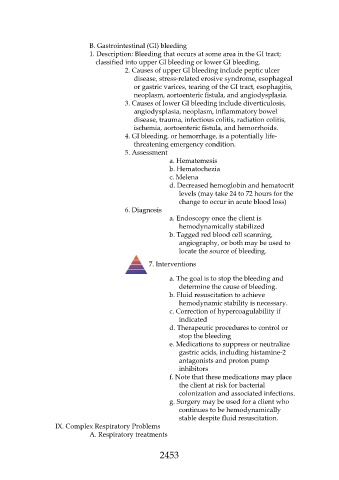Page 2453 - Saunders Comprehensive Review For NCLEX-RN
P. 2453
B. Gastrointestinal (GI) bleeding
1. Description: Bleeding that occurs at some area in the GI tract;
classified into upper GI bleeding or lower GI bleeding.
2. Causes of upper GI bleeding include peptic ulcer
disease, stress-related erosive syndrome, esophageal
or gastric varices, tearing of the GI tract, esophagitis,
neoplasm, aortoenteric fistula, and angiodysplasia.
3. Causes of lower GI bleeding include diverticulosis,
angiodysplasia, neoplasm, inflammatory bowel
disease, trauma, infectious colitis, radiation colitis,
ischemia, aortoenteric fistula, and hemorrhoids.
4. GI bleeding, or hemorrhage, is a potentially life-
threatening emergency condition.
5. Assessment
a. Hematemesis
b. Hematochezia
c. Melena
d. Decreased hemoglobin and hematocrit
levels (may take 24 to 72 hours for the
change to occur in acute blood loss)
6. Diagnosis
a. Endoscopy once the client is
hemodynamically stabilized
b. Tagged red blood cell scanning,
angiography, or both may be used to
locate the source of bleeding.
7. Interventions
a. The goal is to stop the bleeding and
determine the cause of bleeding.
b. Fluid resuscitation to achieve
hemodynamic stability is necessary.
c. Correction of hypercoagulability if
indicated
d. Therapeutic procedures to control or
stop the bleeding
e. Medications to suppress or neutralize
gastric acids, including histamine-2
antagonists and proton pump
inhibitors
f. Note that these medications may place
the client at risk for bacterial
colonization and associated infections.
g. Surgery may be used for a client who
continues to be hemodynamically
stable despite fluid resuscitation.
IX. Complex Respiratory Problems
A. Respiratory treatments
2453

